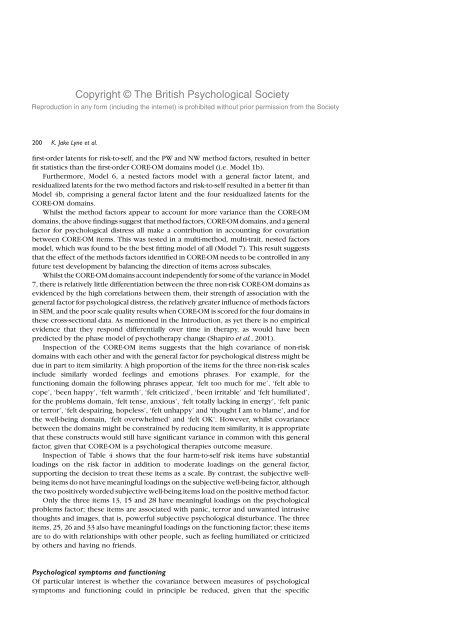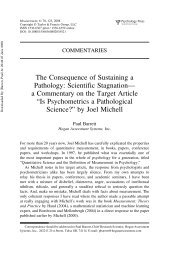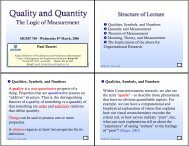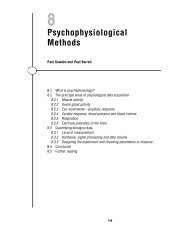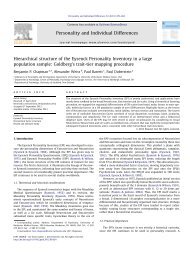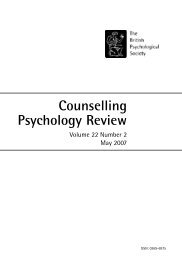Dimensions of variation on the CORE-OM - Paul Barrett
Dimensions of variation on the CORE-OM - Paul Barrett
Dimensions of variation on the CORE-OM - Paul Barrett
Create successful ePaper yourself
Turn your PDF publications into a flip-book with our unique Google optimized e-Paper software.
Copyright © The British Psychological SocietyReproducti<strong>on</strong> in any form (including <strong>the</strong> internet) is prohibited without prior permissi<strong>on</strong> from <strong>the</strong> Society200K. Jake Lyne et al.first-order latents for risk-to-self, and <strong>the</strong> PW and NW method factors, resulted in betterfit statistics than <strong>the</strong> first-order <strong>CORE</strong>-<strong>OM</strong> domains model (i.e. Model 1b).Fur<strong>the</strong>rmore, Model 6, a nested factors model with a general factor latent, andresidualized latents for <strong>the</strong> two method factors and risk-to-self resulted in a better fit thanModel 4b, comprising a general factor latent and <strong>the</strong> four residualized latents for <strong>the</strong><strong>CORE</strong>-<strong>OM</strong> domains.Whilst <strong>the</strong> method factors appear to account for more variance than <strong>the</strong> <strong>CORE</strong>-<strong>OM</strong>domains, <strong>the</strong> above findings suggest that method factors, <strong>CORE</strong>-<strong>OM</strong> domains, and a generalfactor for psychological distress all make a c<strong>on</strong>tributi<strong>on</strong> in accounting for co<str<strong>on</strong>g>variati<strong>on</strong></str<strong>on</strong>g>between <strong>CORE</strong>-<strong>OM</strong> items. This was tested in a multi-method, multi-trait, nested factorsmodel, which was found to be <strong>the</strong> best fitting model <str<strong>on</strong>g>of</str<strong>on</strong>g> all (Model 7). This result suggeststhat <strong>the</strong> effect <str<strong>on</strong>g>of</str<strong>on</strong>g> <strong>the</strong> methods factors identified in <strong>CORE</strong>-<strong>OM</strong> needs to be c<strong>on</strong>trolled in anyfuture test development by balancing <strong>the</strong> directi<strong>on</strong> <str<strong>on</strong>g>of</str<strong>on</strong>g> items across subscales.Whilst <strong>the</strong> <strong>CORE</strong>-<strong>OM</strong> domains account independently for some <str<strong>on</strong>g>of</str<strong>on</strong>g> <strong>the</strong> variance in Model7, <strong>the</strong>re is relatively little differentiati<strong>on</strong> between <strong>the</strong> three n<strong>on</strong>-risk <strong>CORE</strong>-<strong>OM</strong> domains asevidenced by <strong>the</strong> high correlati<strong>on</strong>s between <strong>the</strong>m, <strong>the</strong>ir strength <str<strong>on</strong>g>of</str<strong>on</strong>g> associati<strong>on</strong> with <strong>the</strong>general factor for psychological distress, <strong>the</strong> relatively greater influence <str<strong>on</strong>g>of</str<strong>on</strong>g> methods factorsin SEM, and <strong>the</strong> poor scale quality results when <strong>CORE</strong>-<strong>OM</strong> is scored for <strong>the</strong> four domains in<strong>the</strong>se cross-secti<strong>on</strong>al data. As menti<strong>on</strong>ed in <strong>the</strong> Introducti<strong>on</strong>, as yet <strong>the</strong>re is no empiricalevidence that <strong>the</strong>y resp<strong>on</strong>d differentially over time in <strong>the</strong>rapy, as would have beenpredicted by <strong>the</strong> phase model <str<strong>on</strong>g>of</str<strong>on</strong>g> psycho<strong>the</strong>rapy change (Shapiro et al., 2001).Inspecti<strong>on</strong> <str<strong>on</strong>g>of</str<strong>on</strong>g> <strong>the</strong> <strong>CORE</strong>-<strong>OM</strong> items suggests that <strong>the</strong> high covariance <str<strong>on</strong>g>of</str<strong>on</strong>g> n<strong>on</strong>-riskdomains with each o<strong>the</strong>r and with <strong>the</strong> general factor for psychological distress might bedue in part to item similarity. A high proporti<strong>on</strong> <str<strong>on</strong>g>of</str<strong>on</strong>g> <strong>the</strong> items for <strong>the</strong> three n<strong>on</strong>-risk scalesinclude similarly worded feelings and emoti<strong>on</strong>s phrases. For example, for <strong>the</strong>functi<strong>on</strong>ing domain <strong>the</strong> following phrases appear, ‘felt too much for me’, ‘felt able tocope’, ‘been happy’, ‘felt warmth’, ‘felt criticized’, ‘been irritable’ and ‘felt humiliated’,for <strong>the</strong> problems domain, ‘felt tense, anxious’, ‘felt totally lacking in energy’, ‘felt panicor terror’, ‘felt despairing, hopeless’, ‘felt unhappy’ and ‘thought I am to blame’, and for<strong>the</strong> well-being domain, ‘felt overwhelmed’ and ‘felt OK’. However, whilst covariancebetween <strong>the</strong> domains might be c<strong>on</strong>strained by reducing item similarity, it is appropriatethat <strong>the</strong>se c<strong>on</strong>structs would still have significant variance in comm<strong>on</strong> with this generalfactor, given that <strong>CORE</strong>-<strong>OM</strong> is a psychological <strong>the</strong>rapies outcome measure.Inspecti<strong>on</strong> <str<strong>on</strong>g>of</str<strong>on</strong>g> Table 4 shows that <strong>the</strong> four harm-to-self risk items have substantialloadings <strong>on</strong> <strong>the</strong> risk factor in additi<strong>on</strong> to moderate loadings <strong>on</strong> <strong>the</strong> general factor,supporting <strong>the</strong> decisi<strong>on</strong> to treat <strong>the</strong>se items as a scale. By c<strong>on</strong>trast, <strong>the</strong> subjective wellbeingitems do not have meaningful loadings <strong>on</strong> <strong>the</strong> subjective well-being factor, although<strong>the</strong> two positively worded subjective well-being items load <strong>on</strong> <strong>the</strong> positive method factor.Only <strong>the</strong> three items 13, 15 and 28 have meaningful loadings <strong>on</strong> <strong>the</strong> psychologicalproblems factor; <strong>the</strong>se items are associated with panic, terror and unwanted intrusivethoughts and images, that is, powerful subjective psychological disturbance. The threeitems, 25, 26 and 33 also have meaningful loadings <strong>on</strong> <strong>the</strong> functi<strong>on</strong>ing factor; <strong>the</strong>se itemsare to do with relati<strong>on</strong>ships with o<strong>the</strong>r people, such as feeling humiliated or criticizedby o<strong>the</strong>rs and having no friends.Psychological symptoms and functi<strong>on</strong>ingOf particular interest is whe<strong>the</strong>r <strong>the</strong> covariance between measures <str<strong>on</strong>g>of</str<strong>on</strong>g> psychologicalsymptoms and functi<strong>on</strong>ing could in principle be reduced, given that <strong>the</strong> specific


